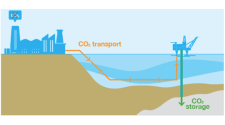
Quintessa has recently supported the Northern Endurance Partnership (NEP) through independent review of subsurface Early Risk Assessments for the expansion stores beyond Phase 1 at the Endurance store. This work builds on the support that Quintessa provided to the NEP previously, which focussed on reviewing its subsurface risk management plan for the Endurance store.
The Northern Endurance Partnership (NEP) brings together world-class organisations with the shared goal of decarbonizing of the UK’s largest industrial clusters, the Humber and Teesside, as it offers access to the Endurance carbon store in the southern North Sea, which has the capacity to store 450 million tonnes of CO2. The NEP project meets the CCS’s recommendations and HM Government’s Ten Point Plan in relation to establishment of Carbon Capture, Usage and Storage (CCUS) clusters, which will contribute to the UK’s leadership in the energy transition and the emerging global low-carbon and hydrogen market. Quintessa previously provided support to the NEP in reviewing its subsurface risk assessment and management plan for the Endurance store.
In order to accommodate potential future volumes from Humber and Teesside industrial clusters, the NEP was awarded two carbon storage (CS) licenses for the area covering the Bunter Structure BC36, 37, 39 & 40 stores located 40 to 80 km to the east of Endurance. In line with the NEP’s licence requirements for the expansion stores and the regulatory guidance, Quintessa provided an independent review of an Early Risk Assessment (ERA) and presented a summary of its findings at the ERA Workshop attended by the North Sea Transition Authority (NSTA) and the NEP. As a part of the review processes, Quintessa aimed to ensure that the elements of concern and risk evaluation criteria were appropriate; the uncertainty and sources of bias in the risk evaluation were identified; and the results were documented in a transparent and consistent manner.
This work is an important step in the appraisal term of the CS licence as it ensures that potential threats to storage capacity and injectivity and any critical risks to the containment of CO2 are identified, uncertainties assessed, and further studies to address those uncertainties highlighted. Quintessa’s participation in the project built on our existing expertise and knowledge in the sustainable utilisation of the subsurface, and demonstrated our continual commitment in providing a leading-edge scientific input and consultancy to facilitate a low carbon future.